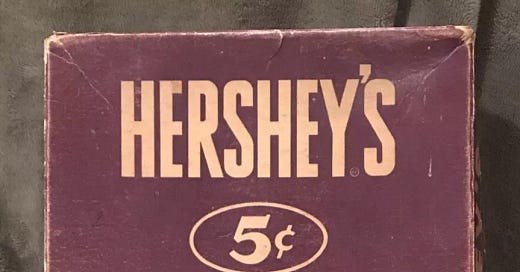Shrinkflation—reducing product sizes while keeping prices the same—is nothing new. But before it became today’s favorite sneaky tactic for managing rising costs, it had a surprisingly honest origin story. Let’s take a moment to give credit where it’s due: the Acquired podcast’s brilliant Mars Inc. episode. They masterfully unpack the chocolate wars between Mars and Hershey, including Hershey’s early flirtation with shrinkflation. If you haven’t listened to it yet, do yourself a favor and dive in.
Now, let’s talk about Hershey and why their approach to shrinkflation might be the high-water mark for corporate honesty in tough times.
Hershey’s “Honest Shrinkflation”
Hershey famously kept the price of its chocolate bar at just five cents for almost seven decades—yes, nearly 70 years. This wasn’t some marketing gimmick; it was a promise to consumers that Milton Hershey himself believed in. Even as costs for ingredients like sugar and cocoa shot up over time, Hershey refused to raise prices.
But keeping that promise wasn’t easy. Instead of charging more, Hershey turned to a simple solution: shrink the chocolate bar and they didn’t try to hide it. It was straightforward: the bar was smaller, but the price stayed the same. No flashy “new and improved!” labels. There are no packaging tricks. Just a smaller chocolate bar to reflect economic realities.
Compare that to today. Modern shrinkflation feels like a Jedi mind trick: packaging stays nearly identical, labels scream “value!” and consumers don’t realize they’re getting less until they’ve already bitten into it. Hershey’s approach may not have been flashy, but at least it was upfront.
The Reluctant Price Hike
Hershey’s commitment to affordability held strong until 1969, when rising costs finally forced the company to raise the price of its chocolate bar to 10 cents. That’s almost 70 years of resisting inflation pressures—an unthinkable timeline in today’s economy. The reluctance to raise prices wasn’t just about stubbornness; it reflected Hershey’s core belief that chocolate should be accessible to everyone.
This starkly contrasts modern practices, where many companies use shrinkflation and price hikes in tandem, doubling down on tactics that feel more like deception than adaptation.
What Today’s Companies Can Learn from Hershey
Shrinkflation has always been about survival. It’s a tactic to manage costs without shocking customers with price hikes. But the way it’s deployed makes all the difference. Hershey treats its consumers with honesty that feels refreshingly rare compared to today’s shell games. They didn’t insult their customers’ intelligence with flashy marketing spins—they just made tough decisions and trusted their audience to understand.
It’s a lesson in transparency, accountability, and trust—values we at the Marketing Accountability Council (MAC) hold near and dear. Shrinkflation is tough, but being upfront about it can make all the difference in maintaining consumer loyalty.
Sometimes, the sweetest stories come with a bitter truth—and a whole lot of marketing lessons.




